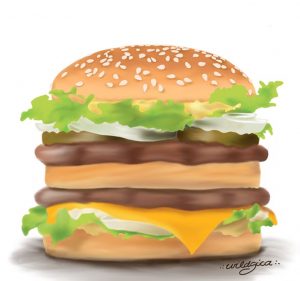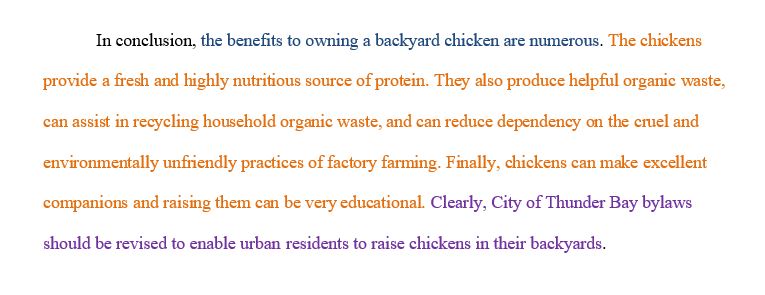12 Writing the Concluding Paragraph
In the chapter on introductions, you learned that the introductory and concluding paragraphs are like the top and bottom buns of a hamburger. They contain basically the same information and are critical for holding the entire piece together. Now we’ll focus on the concluding paragraph.
Learning Objectives
After completing the exercises in this chapter, you will be able to
- identify the components of a concluding paragraph
- learn how to conclude your paper with impact
Essay Structure
You learned previously that a body paragraph is structured like a hamburger. You can think of your essay as one big burger!

The top bun is the introduction.
The meat and vegetables in the middle are the supporting body paragraphs (several mini-burgers).
The bottom bun is the conclusion.
“Burger” by wildgica under license CC BY-NC-ND 3.0.
The top and bottom bun are both made of bread; they contain the same ingredients (or information) but look a little bit different. The “meat” of your argument is in the supporting body paragraphs.
Concluding Paragraphs
The most important thing to remember about the conclusion is that it shouldn’t state any new information. The purpose of the concluding paragraph is to summarize the main points of your argument.
The concluding paragraph has three main goals:
- Restate your stance on the topic
- Summarize the main topics (from the body paragraphs) that support your stance
- Close the essay effectively with a powerful final statement
Your final statement might be a general thought about the topic, a prediction that is logically based on the evidence you presented in the supporting paragraphs, or a call to action in which you ask the reader to do something in light of the persuasive information you’ve presented.
Examples:
- general thought: Nuclear power is a far greater resource than many people realize.
- prediction: Nuclear power will be the energy of the future.
- call to action: Governments need to invest in nuclear power so it can reach its full potential.
Watch this video to learn some great tips for how to write a great concluding paragraph[1]:
While Mister Messinger says your conclusion can be more than one paragraph, most teachers are expecting a one-paragraph conclusion, so it’s best to stick to just one paragraph!
One really effective strategy is to link your conclusion to your introduction by continuing an idea that was introduced in the introductory paragraph.
Examples:
- if you began with an anecdote in your introduction, you can finish it in the conclusion
- if you posed a question in the introduction, you can answer it in the conclusion
- if you highlighted a problem in the introduction, you can suggest a solution in the conclusion
Sample Concluding Paragraph
Let’s look at the concluding paragraph for the essay on raising chickens:

The writer starts by restating her thesis (in blue). She remind readers of her topic (raising chickens) and her point of view (that raising chickens is beneficial).
The writer then restates, or summarizes, the reasons she’s given for her point of view (in orange). All of the information in orange was thoroughly discussed in body paragraphs. Notice that the writer doesn’t need to include any citations here because she isn’t introducing any new or highly specific information.
The writer ends with a call to action (in purple). She tells the readers what she thinks the next step should be, based on the research she’s presented.
- Mister Messinger. (2020, August 19). End your essay (part 1): How to write a conclusion paragraph [Video]. YouTube. https://www.youtube.com/watch?v=lv8tLxFVGuw ↵

